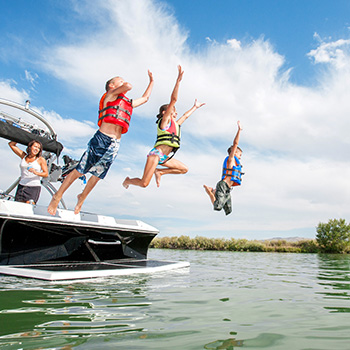Water Safety
Spring Break is in full swing, and now that you know how to travel safely, prevent skin cancer, and protect yourself at night we’ll discuss staying safe in the water both in the spring and throughout the year!
Water Safety Statistics:
- 80% of drowning victims are male
- Approximately 30% of children aged 1-4 who die from unintentional injury die from drowning
- 70% of deaths from recreational water activities involve alcohol
- In 88% of boating-related drowning deaths, the victim was not wearing a life jacket
Contributing Factors to Drowning and How to Prevent Them
Alcohol – Alcohol affects your coordination, judgment, and balance which are all things you need when participating in water activities. The effects of alcohol are also heightened when you are out in the sun for a long period of time. Try to limit alcohol use until after your water activities.

Failure to Wear Life Jacket – For activities such as boating, jet skiing, water skiing, white water rafting, etc. it is extremely important to wear a life jacket. In the event something happens where you are stranded in the water, the life jacket will prevent you from exhausting yourself treading water. It is also possible you may lose consciousness if you are thrown hard from a watercraft, making the life jacket the only means of keeping you afloat. In fact in many states it is illegal to have more people on a water craft than there are life jackets.
Lack of Supervision – Even with a lifeguard present or in shallow water, drowning can happen. Always make sure you are looking out for the people you are with, and that they are looking out for you.
Holding Breath for a Long Time – Attempting to hold your breath for a long time can cause you to pass out. Try to avoid swimming very deep or staying under water too long. Passing out can cause someone to drown even in shallow water.
Rip Currents – When swimming in the ocean be sure to check if there are any rip tides present. Beaches have flags and warning signs indicating potential hazards, which can also include choppy waves and jellyfish. Be sure you check the flags before swimming.
Rip currents can sometimes be seen from shore as a channel of choppy, foamy, debris filled water. Do not swim directly against a rip current. It is too strong, and you will tire yourself out. If caught in one, swim parallel to shore until you are out of it. Then swim diagonally towards shore away from the rip current.
CPR
If you plan on doing extreme water sports or are around water frequently it is a good idea to learn CPR. While it may seem scary to perform such a procedure on someone, in the absence of paramedics or trained life guards a civilian who attempts CPR could be the difference between life and death for the victim. Of course the first step if someone is unconscious is to call 911.
The steps to CPR can be remembered with the acronym CAB: circulation, airway, and breathing.
Circulation: First you want to determine if the victim has a heartbeat by taking their pulse. If you cannot find a pulse, begin chest compressions with the victim lying on a firm surface. Place the heel of one hand between the person’s nipples then place your other hand on top. Keeping your elbows straight and using your entire upper body weight, push the chest down at least 2 inches. Repeat at a rate of about 2 compressions per second.
Airway: After you have done about 30 compressions, check to see if the victim’s airway is clear. You will want to lift their chin up and tilt the head back to open the airway. It is highly advisable that you only do this if you are trained in CPR, as moving an injured person’s neck can cause further injury.
Breathing: Once the airway is open you can perform breathing for the victim using mouth-to-mouth resuscitation. Breathe into the person’s mouth for one full second while checking to see if the chest is rising. If not, you may not have cleared the airway completely and may need to tilt the head back further. If the chest is rising, perform two full breaths then resume chest compressions. Continue to alternate 30 compressions and 2 breaths.
These steps are merely guidelines for the CPR procedure and not meant to replace formal CPR training. This training can come in handy in many areas of life, not just water sports, so it can’t hurt to take a class and always be prepared.
Water sports and swimming are a fun way to enjoy your spring break as long as safety is kept in mind as well. By taking some precautions, limiting alcohol, and wearing life jackets you can have a splashing spring break.
Categorized in: Safety Tips, Spring Break Safety
